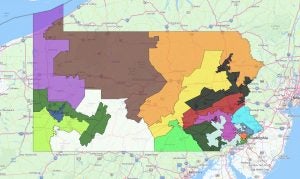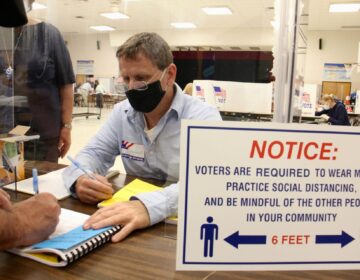Interactive map: GOP proposal for new Pa. congressional map sparks debate about fairness, partisanship
Some political analysts have raised red flags about partisanship within the proposed map.
The interactive map above shows the boundaries of Pennsylvania’s 18 congressional districts as proposed by top Republicans. Editor’s note: This story published Monday night. On Tuesday, Gov. Wolf rejected the GOP proposal. Read the latest here.
The proposed congressional district map from Pennsylvania GOP leaders seems to meet some of the key criteria laid out by the Pennsylvania Supreme Court. It’s geographically more compact and divides significantly fewer counties and municipalities than the 2011 map. It also adheres to the Voting Rights Act and preserves the state’s two minority-majority congressional districts.
But some political analysts have raised red flags about partisanship within the proposed map.
The court ordered the state legislature to draw a new map after it ruled the current version an unconstitutional partisan gerrymander last month.
Just under the wire of the court-imposed deadline, House Speaker Mike Turzai (R-Allegheny) and Senate President Pro Tempore Joe Scarnati (R-Jefferson) submitted changes to Governor Tom Wolf on Friday evening, bypassing any votes from members of the House and Senate.
“Gone are the ridiculous lines of the 7th [Congressional District],” said Christopher Borick, a political science professor at Muhlenberg College. “The famed Goofy kicking Donald Duck district that’s drawn a lot of scorn — you don’t see that in this map.”
But looking closer, Borick says he wouldn’t expect the political shape of the state’s congressional delegation to change much in the next election cycle.
For the last three elections, Republicans have held 13 congressional seats to Democrats’ five, and he expects a similar Republican advantage to hold if the GOP plan is approved.
“It doesn’t necessarily look like it might have a big impact on the partisan representation of the congressional delegation from Pennsylvania,” said Borick. “And, at the end of the day that’s part of the court’s reading of why they threw out the former lines.”
This point raises a few key questions. Although the proposed map may satisfy some of the court’s standards, are the changes enough to pass legal muster with the state’s Democratic-majority high court? And when does a map with a partisan tilt become unconstitutional?
Top Democrats in the House and Senate — pressing for a map that would predict a more evenly split congressional delegation — have called on Wolf to reject the GOP proposal.
In a written statement, plaintiffs in the case called the proposal “a naked partisan gerrymander just as much as the unconstitutional 2011 map.”
GOP leaders say their proposal fully complies with the court order. Senate Republican spokeswoman Jennifer Kocher tweeted about the issue Monday, writing, “those who are looking at the politics are the people who asked that politics be removed from the process.”
We were told the map needed to be compact. The map is compact. We were told the map needed to be contiguous. The map is contiguous. They wanted a more visually pleasing map w/ less meandering lines. The map does that. We wanted to limit the confusion factor for voters. 1/2
— Jenn Kocher (@jkocher156) February 12, 2018
More competitive, more safe
In his analysis, David Wasserman, a national political analyst with The Cook Political Report, says that races in the Philly suburbs’ 7th Congressional District and the Lehigh Valley’s 15th Congressional District would likely become more competitive with the proposed map.
But that was also expected under the old map since neither Republican Congressman Charlie Dent (PA-15) nor Republican Congressman Pat Meehan is running for re-election.
“Those [districts] aren’t difficult for Republicans to sacrifice because they don’t have incumbents they need to protect in those places anymore,” said Wasserman.
In making the 7th and 15th Congressional Districts more competitive, Wasserman says incumbents in neighboring districts such as Republican Ryan Costello (PA-6) and Republican Lloyd Smucker (PA-16) may find the new map strengthens their chances at re-election.
Over the weekend, Mike Johnson, data director at the Pennsylvania AFL-CIO, did his own independent analysis of the proposed map.
He broke it down, district by district, by past election results from 2010 – 2016.
“Districts don’t have to look like spaghetti in order to be gerrymandered,” said Johnson. “Gerrymandering is really about the goal and the intent of trying to protect incumbents or protect particular parties.”
Overall, he found districts safer for Republicans and safer for Democrats.
Digging deeper into the map, Johnson cites southeastern Pennsylvania as a prime example of potential partisan gerrymandering.
Montgomery County, which has more than enough population to make up its own congressional district is split between four districts. That’s one fewer split than the previous map.
On the western side of the state, under the proposed map, the 18th Congressional District would include more of Westmoreland County, which has been trending Republican, says Johnson.
He notes the district also cuts out Democratic candidate Conor Lamb, who is competing for the seat with Republican State Rep. Rick Saccone. Saccone’s house would remain inside the district boundary.
After releasing the map on Friday, Drew Crompton, chief of staff for Sen. Scarnati, said the GOP leaders didn’t consider past voter performance and party registration in their new proposal.
“I can recognize some districts being more competitive and less competitive, but that’s as far as I know,” said Crompton.
On that point, Wasserman was skeptical.
“The chances that Pennsylvania Republicans didn’t take partisanship into account when drawing this map are about the same as the odds of Philadelphia capsizing into the Delaware River.”
He added that if Democrats were in power they would take the same partisanship into account and use it to their advantage.
Crompton stressed that the GOP had other guideposts in mind when creating the new map, including keeping Erie and Lancaster whole, and creating a seat that represents the Lehigh Valley. He says, next, they took incumbency into consideration and wanted to limit voter confusion.
“That’s it. No political influence,” wrote Crompton in an email. “Rather we focused on the Supreme Court direction. The Democrats and the League of Women Voters were bombastic about the shapes of the 2011 districts and we constitutionally addressed that issue. And now they are claiming foul? Absurd.”
The proposed map is now in the hands of the Democratic governor and he has until Thursday to approve or reject the GOP plan.
Borick says Wolf has a challenging decision to make.
“If he agrees with the map, it certainly would anger some people on the left, who see this as not going far enough,” said Borick. “I think it would set up a little bit of a positive relationship with some Republicans in the legislature saying that he was willing to compromise on this and that they have a good faith effort.”
The Pennsylvania Supreme Court could also intercede before he has a chance to act, finding that the legislature already broke its part of the bargain by not getting the consensus of the General Assembly through formal legislation.
If the court remains silent and Wolf dissents from the GOP plan, he said Monday that he might offer his own map.
The court said all parties may submit a remedial plan on or before Thursday.
The court may also take over the process and draw its own map. It’s called for the entire process to be complete by Monday, Feb. 19.
WHYY is your source for fact-based, in-depth journalism and information. As a nonprofit organization, we rely on financial support from readers like you. Please give today.







